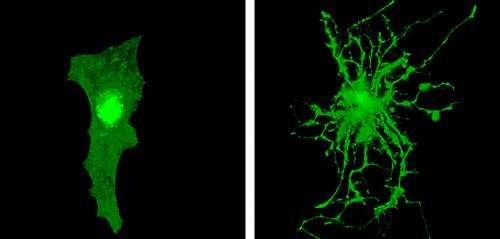The image above shows the difference between an astrocyte in 2D culture (to the left) and in Bioactive3D (to the right). Credit: Magnus Gotander
Researchers at Sahlgrenska Academy in collaboration with Chalmers University of Technology developed a unique Bioactive3D culture system for brain cells. This system gives new possibilities to study cell-cell interactions and disease pathogenesis on cellular and molecular levels.
For decades, it was possible to maintain cells from the brain and other organs alive outside the body and study their functions. Research with cell cultures made substantial contribution to understanding cell and tissue functions in health and disease.
"The cells of the brain, such as astrocytes and neurons, have very advanced morphology that allows complex 3D cell-cell interactions. Standard 2D cell cultures lack the 3rd dimension and this imposes severe limitations to many experiments", says Professor Milos Pekny, director of the Laboratory of Astrocyte Biology and CNS Regeneration and the senior author of the article just published in GLIA.
"Studies into the repair capacity of the brain after neurotrauma, stroke or neurodegenerative diseases would hugely benefit from a 3D cell culture system that provides brain cells with the environment closely mimicking normal and pathological situations in vivo. Such a system might also help to reduce the number of animals used for experimental medical research and facilitate drug discovery and drug development process for biotech companies and pharma industry."
Prof. Pekny's laboratory teamed up with Prof. Johan Liu's research group at Chalmers University of Technology, and several years later, this dream cell culture system became reality.
"We had to define, evaluate and optimize a whole range of technical parameters of the nanofibre-based 3D matrix. We also designed and optimized the coating with extracellular matrix proteins", says Dr. Till Puschmann, the first author of the GLIA study.
The Bioactive3D system minimizes cellular stress and preserves important cellular functions of astrocytes, the cells that control many functions of neuronal cells in the brain. The system is currently being optimized for neurons.
"We benefited a lot from combining our respective expertise", says Milos Pekny. We believe that the Bioactive 3D system will soon allow many researchers to do experiments which were previously impossible.
More information: The article "Bioactive 3D cell culture system minimizes cellular stress and maintains the In vivo-Llike morphological complexity of astroglial cells" was published in GLIA.
Provided by Chalmers University of Technology



















